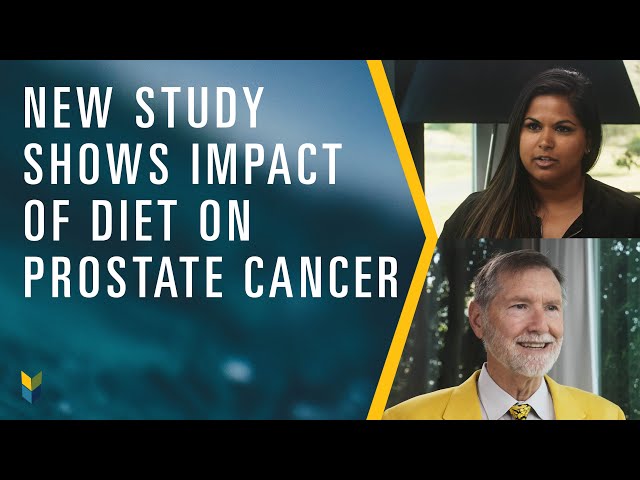Research underscores the connections between lifestyle choices, the progression of diseases, and treatment responses SAN DIEGO, Dec. 7, 2024 /PRNewswire/ — Five studies showcased at the 66th American Society of Hematology (ASH) Annual Meeting and Exposition unveil new associations between hematologic conditions and dietary habits as well as environmental exposures. By elucidating how nutritional choices and […]

Research underscores the connections between lifestyle choices, the progression of diseases, and treatment responses
SAN DIEGO, Dec. 7, 2024 /PRNewswire/ — Five studies showcased at the 66th American Society of Hematology (ASH) Annual Meeting and Exposition unveil new associations between hematologic conditions and dietary habits as well as environmental exposures. By elucidating how nutritional choices and various lifestyle elements might influence an individual’s risk of developing blood disorders, as well as the progression and treatment outcomes of these conditions, the research indicates potential avenues for intervention via lifestyle changes.
“When a person is confronted with a blood disorder diagnosis or cancer, their immediate emotional reaction is often to question, what might I have done to lead to this outcome, or what steps can I take to fix it?” stated Chancellor Donald, MD, an assistant professor in medicine, hematology, and medical oncology at Tulane University School of Medicine situated in New Orleans. “Our overall lifestyle and dietary habits are among the factors we can most effectively manage. This research directly aligns with the concept of adjusting one’s lifestyle in light of various challenges.”
The initial study indicates possible advantages of using glucagon-like peptide 1 (GLP-1) receptor agonists for diabetes, proposing that these medications could also lower the risk of severe blood clot formation besides their established role in weight management.
Two studies present evidence suggesting that a diet rich in fiber may mitigate complications and slow disease progression by enhancing the gut microbiome’s health. Another study emphasizes the impact of tobacco exposure in cancer emergence and strengthens the argument that quitting smoking could contribute to slowing or halting disease advancement.
The concluding study indicates that a compound linked to ketogenic diets could enhance the efficacy of chimeric antigen receptor (CAR) T-cell therapy, signaling new possibilities for increasing the success rates of this transformative therapy.
GLP-1 Agonists May Lower Risk of Severe Blood Clots in Diabetic Patients
701: Glucagon-like Peptide 1 Receptor Agonists Reduce the Risk of Venous Thromboembolism in Patients with Diabetes Regardless of Obesity: A Propensity Score-Matched Multicenter Database Analysis
Patients with diabetes using GLP-1 receptor agonists, regardless of their weight, faced a 20% lower likelihood of developing venous thromboembolism (VTE) compared to a similar population prescribed a different diabetes medication, based on a comprehensive retrospective study. These findings imply that one overlooked advantage of GLP-1 agonists could be their role in reducing the risks associated with severe blood clots—commonly recognized for their efficacy as both a diabetes treatment and weight loss agent.
“Our analysis demonstrated that using a GLP-1 receptor agonist correlates with a lower incidence of VTE over a year,” commented Rushad Patell, MD, the lead author of the study and an assistant professor in medicine at Harvard Medical School in Boston. “When selecting an antidiabetic medication for a patient with thrombotic considerations, this data suggests a possible advantage in opting for a GLP-1 receptor agonist.”
VTEs, which occur when a blood clot forms in a vein, are among the top preventable in-hospital death causes in the United States, as per the Centers for Disease Control and Prevention. Deep vein thrombosis (DVT), where a clot develops in a deep vein, predominantly in the legs, and pulmonary embolism (PE), where a clot moves to the lungs, are the two variants of VTE, leading to severe complications, extended hospital stays, and mortality.
Initially, GLP-1 receptor agonists received approval from the U.S. Food and Drug Administration (FDA) for enhancing insulin production in diabetic individuals; some medications within this category have also attained approval for weight management in those with obesity. Previous investigations have indicated they may also diminish the risk of cardiovascular ailments, but no prior study has investigated their potential effects on VTE risk.
Researchers reviewed data from over 558,128 type 2 diabetes patients in a large global repository of electronic health records across more than 120 healthcare facilities. Employing a statistical method termed propensity-score matching, they constructed two comparable groups, each comprising nearly 279,064 patients similar in demographics and health conditions, with one distinction: one group received GLP-1 drugs, while the other was treated with a dipeptidyl peptidase-4 inhibitor (DPP4i), a diabetes medication that employs a dissimilar mechanism and lacks weight loss effects.
In the first year post-prescription of their diabetes medication, the incidence rate of VTE per 1,000 patient-years (a metric evaluating the frequency of relatively rare health occurrences over a brief duration) was recorded at 6.5 among GLP-1 drug receivers and 7.9 among DPP4i users, reflecting a 20% diminished risk for patients on GLP-1 receptor agonists. This reduction encompassed decreases in risks for both DVT and PE. Results remained consistent among patients classified as obese up until one year prior to starting their diabetes treatment and those who were not.
Given that obesity is a recognized risk factor for VTE, weight loss might be a potential mechanism through which GLP-1 medications lower VTE risk. However, the findings do not conclusively establish that this risk reduction arises solely from weight loss effects of GLP-1 agonists. Researchers noted that variances between the two study groups began to evident shortly after treatment initiation, possibly indicating other contributing factors, as weight loss typically requires time. “Further research is necessary to ascertain the underlying mechanisms, whether through weight loss or alternative pathways,” Dr. Patell stated.
The robust sample size enhances the reliability of the findings; however, as a retrospective study, researchers cautioned about its limitations compared to a randomized controlled trial. They proposed that subsequent inquiries could elucidate the prospective impacts of GLP-1 medications in individuals without diabetes, those using these drugs specifically for weight loss, and individuals at increased VTE risk due to cancer or other health issues.
“From a public health standpoint, considering the widespread use of these medications, there exists a possibility to assess whether the overall incidence of VTE might be lowered at a national or community level,” Dr. Patell remarked. “The risks associated with VTE seem to continually rise; perhaps this will alter that trend.”
This study received financial backing from the Conquer Cancer Foundation and the National Blood Clot Alliance.
Cho Han Chiang, MD, from Mount Auburn Hospital, will present this study during an oral presentation on Sunday, December 8, 2024, at 5:30 p.m. Pacific time in Room 6CF at the San Diego Convention Center.
A Fiber-Dense Diet May Aid in Preventing Complications Post Stem Cell Transplant
259: Increased Fiber Intake Results in Better Overall Survival and Lower GI-aGVHD in Allo-HCT Recipients and Pre-Clinical Gvhd Models
A high-fiber diet post-stem cell transplantation may minimize the likelihood of graft-versus-host disease (GVHD) through fostering a balanced gut microbiome, as evidenced by studies performed on both patients and mice.
The results contribute to a growing body of research emphasizing the advantages of a high-fiber diet for sustaining microbiome health and imply that commonly recommended dietary restrictions after stem cell transplantation—generally resulting in low fiber consumption—might be counterproductive for certain patients.
“Our research reaffirms findings [regarding dietary fiber benefits] collected outside the realm of GVHD and demonstrates that those ‘guidelines’ are relevant to GVHD as well,” expressed Jenny Paredes, PhD, a staff scientist at City of Hope National Medical Center in Duarte, California, and the lead author of the study. “A significant reduction in fiber intake during transplantation is harmful—it represents a missed opportunity to foster a healthy gut microbiome, recover from treatment-related microbiota damage, and guard against GVHD.”
GVHD is the predominant complication of allogeneic stem cell transplantation, a procedure wherein malignant or abnormal blood stem cells are eradicated and substituted with healthy cells from a donor. GVHD appears when the transplanted cells target the patient’s own tissues, which can result in an array of symptoms ranging from mild to potentially fatal.
Given that patients with GVHD frequently exhibit symptoms akin to irritable bowel disease (IBD) and that stem cell transplantation weakens the immune system, patients are advised to steer clear of raw vegetables and fruits without removable skins for roughly 10 days prior to their procedure and for an additional 30 days, during which most patients remain isolated in the hospital. The purpose of these dietary limitations is to minimize exposure to harmful bacteria and alleviate IBD-like symptoms. However, Dr. Paredes noted that the cooked and processed foods most patients consume during this time are generally lower in fiber. This can disrupt the gut microbiome’s composition and deplete microbial species that thrive on dietary fiber fermentation, a process known to yield beneficial short-chain fatty acids integral to gut health and immunity.
To investigate the potential benefits of sustaining high fiber consumption during stem cell transplantation to avert GVHD, the researchers collaborated with experts at Memorial Sloan Kettering Cancer Center to analyze the diets of 173 patients undergoing the procedure. They monitored all foods and beverages consumed by participants and utilized FDA food databases to calculate fiber and nutrient intake from 10 days before to 30 days after the transplant.
Dr. Paredes and her colleagues discovered that lower fiber intake correlated with diminished gut microbiome diversity, likely increasing susceptibility to infections by intestinal pathogens. Conversely, they noted that a fiber-rich diet was associated with enhanced overall survival rates, reduced incidence of acute GVHD affecting the gastrointestinal tract, and higher microbial diversity within the gut. “A balanced microbiome offers protective benefits; when it’s unbalanced, it may turn into a source of infection and elevate mortality risks,” she remarked.
Patients with greater fiber consumption also exhibited elevated levels of butyrate—a byproduct of dietary fiber fermentation—and had a higher presence of gut microbes that produce butyrate. Prior studies have shown that individuals with more butyrate-producing bacteria in their gut tend to have better survival rates from GVHD than those with lower levels of these microbes.
The research team also explored the mechanisms contributing to these effects through a companion study investigating GVHD and dietary fiber sourced from cellulose—a type of fiber indigestible by mammals without gut microbiota assistance—utilizing mouse models. Mice given a cellulose-rich diet during stem cell transplantation demonstrated a lowered GVHD mortality rate and other indicators of reduced GVHD risk, along with increased microbial diversity and butyrate levels in the gut. According to Dr. Paredes, these findings further substantiate the health advantages of butyrate and other products from fiber fermentation, including enhanced colon health, digestive aid, and inflammation reduction.
Dr. Paredes advised that a high-fiber regimen may not suit every patient. Since fiber fermentation can induce gas and bloating, decreased fiber consumption may alleviate discomfort for those presenting IBD-like symptoms. Future studies could clarify the optimal methods of fiber increase without prompting such symptoms.
Collectively, the findings imply that plant-based, fiber-rich foods could support the maintenance of a healthy gut microbiome and diminish GVHD risks, Dr. Paredes stated. She is currently prioritizing the implementation of new nutritional guidelines at City of Hope and emphasized that healthcare facilities can assist stem cell transplant patients by providing them with varied food options. “The broader our dietary choices, the more diverse our microbiome will be, and this principle applies within clinical settings as well,” remarked Dr. Paredes.
This study was funded by the National Cancer Institute and private charitable organizations.
Jenny Paredes, PhD, from City of Hope National Medical Center, will present this study during an oral presentation on Saturday, December 7, 2024, at 2:00 p.m. Pacific time in Room 6B at the San Diego Convention Center.
High-Fiber Diet May Delay Progression toward Multiple Myeloma
671: A High-Fiber Dietary Intervention (NUTRIVENTION) in Precursor Plasma Cell Disorders Improves Biomarkers of Disease and May Delay Progression to Myeloma
Recent findings indicate that a plant-centric, fiber-rich diet could bolster the prognosis for individuals with precursor conditions that may progress to multiple myeloma (MM). This research, encompassing a 12-week controlled diet coupled with additional health coaching for 20 participants as well as tests on mice, marks the first intervention study illustrating that dietary modifications centered around fiber can potentially decelerate the advancement of blood cancers.
MM manifests as a cancer of plasma cells, a subset of white blood cells. The development begins gradually, starting from one of two precursor states known as monoclonal gammopathy of undetermined significance (MGUS) and smoldering multiple myeloma (SMM). Given that these stages can persist for extended periods without transforming into MM, researchers are exploring methods to intervene and avoid cancer progression in patients with MGUS or SMM, as there is currently no definitive cure for MM.
“As we increasingly identify cancers in their early, precancerous stages, there lies a greater chance to comprehend how lifestyle changes can influence disease trajectories and improve patient quality of life,” asserted Urvi A. Shah, MD, principal investigator of the NUTRIVENTION trial and an attending physician at Memorial Sloan Kettering Cancer Center in New York. “It’s exceedingly daunting for someone to learn they are in a precancerous stage with no clear actions available to them. We aim to empower patients to take proactive steps to mitigate their risks.”
Overweight individuals experience an elevated risk of developing MM, and prior studies indicate that dietary factors and gut microbiome health may play roles in disease progression. Dr. Shah and her team conducted a pilot clinical trial involving 20 subjects (median age 62, comprised of 11 females and nine from underrepresented racial and ethnic backgrounds) presenting with MGUS or SMM and a body mass index of 25 or higher to assess if a high-fiber, plant-based diet could be practical and potentially prevent disease advancement.
The trial spanned over a year. For the initial three months, participants received set meals featuring six lunches and dinners weekly along with virtual nutritional coaching to assist them in adopting a fiber-rich regimen involving beans, legumes, whole grains, produce, while excluding animal products and processed foods. For the next three months, individuals continued nutritional coaching but were responsible for preparing their meals. No meals or coaching were provided in the final portion of the year.
The trial achieved its primary goals regarding feasibility, with participants showing robust adherence and considerable weight reduction. During the first three months, median adherence to the high-fiber, plant-based regimen was 91%, dropping to 58% by the year’s end, markedly higher than the 20% adherence observed prior to the study. Participants lost an average of 7% of their body weight within the first three months, a reduction sustained throughout the year. They also reported improvements in quality of life and various biochemical indicators, including those related to insulin sensitivity, diversity in fecal microbiome, and levels of inflammation.
“We observed enhancements across multiple aspects, such as metabolism, microbiome health, and immune markers, with two patients experiencing progressive disease exhibiting stabilization and deceleration during the intervention,” Dr. Shah remarked. “Though only a couple of cases, to our knowledge, there hasn’t been prior indication in an intervention setting that lifestyle and dietary improvement can actually decelerate or alter disease trajectories.”
At the Bellone laboratory at IRCSS San Rafaele Hospital in Milan, Italy, a parallel experiment on SMM was conducted using a mouse model. Inside this model, the consumption of a fiber-rich diet extended the time to progress to MM, with a median duration of 12 weeks on a standard diet versus 30 weeks for those on a high-fiber regimen. All mice in the control group progressed to MM, while 40% of high-fiber diet mice evaded the disease.
“Mechanistically, we discovered that the beneficial effects conferred by a high-fiber diet were comparable in both overweight and lean mice, even during advanced disease stages,” Dr. Shah noted. “The efficacy of the dietary approach appeared independent of calorie consumption and was not solely attributable to weight loss.” Biochemical evaluations indicated that increased microbial diversity and particular compounds generated by gut bacteria might serve as mechanisms for retarding disease progression by inhibiting the growth of abnormal plasma cells, reducing inflammation, and enhancing immune responses.
Researchers acknowledged that findings from mice may not directly translate to humans and that the clinical trial was constrained by its limited sample size, complicating the understanding of why some subjects experienced changes in progression while others did not. A follow-up study is currently being initiated to further explore the dietary changes and/or supplements that might affect MM progression within a larger cohort of patients.
This research received support from the American Society of Hematology, the National Cancer Institute, the Allen Foundation Inc, the Paula and Rodger Riney Foundation, the Solomon Fund, the AIRC Foundation for Cancer Research, and the Leukemia and Lymphoma Society.
Urvi Shah, MD, from the Memorial Sloan Kettering Cancer Center, will present this study during an oral presentation on Sunday, December 8, 2024, at 5:30 p.m. Pacific time in Pacific ballrooms 24-26 at the Marriott Marquis San Diego Marina.
Smoking Associated with Genetic Mutations That Exacerbate Myelodysplastic Syndromes
4597: Association between Smoking Intensity, Genetic Mutations, and Disease Progression in Myelodysplastic Syndromes
For the first time, research has shed light on how smoking—a recognized risk factor for various cancer types—may contribute to the development of a class of blood cancers referred to as myelodysplastic syndromes (MDS) through specific genetic mutations. The new discoveries suggest that these damaging mutations accumulate over time, providing insight into why individuals with a heavier smoking history may encounter poorer outcomes with MDS.
“We have demonstrated that tobacco smoking correlates with particular genetic mutations linked to MDS; prolonged smoking duration leads to a higher accumulation of mutations and a greater likelihood of progressing to MDS,” stated Sangeetha Venugopal, MD, the study’s lead author and a physician at Sylvester Comprehensive Cancer Center at the University of Miami Miller School of Medicine. “Our findings illustrate a definitive dose-response relationship and a significant association between disease advancement and overall survival.”
MDS typically develop gradually from multiple precursor states and impair the bone marrow’s capacity to generate healthy blood cells. Considered a form of cancer, MDS can also advance to acute myeloid leukemia, a more aggressive blood cancer. Numerous investigations have linked smoking with lung cancer and other solid tumors, though the genetic pathways connecting smoking to blood cancers like MDS remain insufficiently understood.
Researchers evaluated genetic data, smoking habits, and disease progression in almost 1,900 participants enrolled in the National MDS Study—the largest prospective national research on individuals diagnosed with MDS or one of its precursor conditions. Approximately half of the participants had a history of smoking, with 18% still smoking at diagnosis. Among those with any smoking history, many were heavy tobacco users, averaging around 16 cigarettes per day for close to 30 years. Over two-thirds of long-term smokers were male, and nearly half were in their seventies.
By contrasting smokers with non-smokers while adjusting for age, sex, and disease type, the researchers determined that smokers bore significantly higher mutation rates, particularly among those who smoke the most. Those in the 75th and 90th percentiles for pack-years—a measure accounting for both smoking intensity and duration—exhibited 1.8 and 3.5 times the number of mutations compared to non-smokers, respectively.
Individuals with extended smoking histories were also markedly more likely to experience disease progression than those with shorter smoking durations or who had never smoked, with 27% of long-term smokers witnessing progression, compared with 18% among non-smokers or those with brief smoking experiences. Some mutations identified in the research, such as ASXL1, had been previously linked to smoking, while several others had not.
Given the results indicating a clear dose-response relationship—showing that increased smoking duration leads to a greater mutation count—the researchers suggested that smoking cessation could potentially curtail MDS risk for those with precursor conditions, and might also mitigate the progression of MDS into more aggressive forms of cancer. Healthcare professionals can assist patients by repeatedly addressing the subject—acknowledging that quitting can be particularly tough for lifelong smokers—and facilitating access to smoking cessation resources.
“This study provides a compelling rationale for physicians to engage in discussions with patients who may still be smoking upon diagnosis, informing them of the progression risks and encouraging tobacco cessation,” Dr. Venugopal explained. “My intention is not to prompt patients to feel guilt about their blood cancers, but also not to have them maintain an unhealthy habit that could adversely impact their disease advancement; thus, achieving a balance is essential.”
Since the research relied on data from individuals with MDS or related conditions, it remains uncertain whether some of the mutations identified also exist in smokers without these diseases. Researchers advocated for future studies involving smokers without MDS or similar conditions to enhance understanding of the genetic mechanisms and associated risks.
This study received funding from the National Heart, Lung, and Blood Institute.
Sangeeta Venugopal, MD, MS, from the University of Miami Miller School of Medicine, will present this study in a poster on Monday, December 9, 2024, at 6:00 p.m. Pacific time in Halls G-H at the San Diego Convention Center.
Ketogenic Diet Enhances CAR T-Cell Efficacy for Improved Tumor Management
4: Ketogenic Diet Enhances CAR T Cell Antitumor Function Via β-Hydroxybutyrate
Investigations conducted on mice, human tissue, and healthy participants indicate that a ketogenic diet may amplify the effects of CAR T-cell therapy. The findings suggest that β-hydroxybutyrate (BHB)—a compound generated when adhering to a ketogenic regimen—serves as a catalyst for enhancing CAR T-cell functionality against malignancies.
In CAR-T therapies, a patient’s immune cells are extracted, genetically modified, and reintroduced into their body where they are designed to identify and destroy cancer cells. The FDA has sanctioned several CAR-T treatments for various types of blood cancers.
“Our findings revealed that a ketogenic diet can bolster CAR T-cell activity, further identifying BHB as a critical metabolite responsible for this enhancement,” stated Shan Liu, PhD, a postdoctoral researcher at the Perelman School of Medicine at the University of Pennsylvania in Philadelphia, and a principal author on the study. “Considering that approximately two-thirds of patients undergoing CAR-T therapy either fail to respond or eventually experience relapse, a dietary approach that can be easily integrated with CAR-T treatment would be highly advantageous.”
Diet has a documented influence on general health and also affects patients’ reactions to various cancer therapies. For instance, prior studies have demonstrated that a high-fiber diet may impact the efficacy of a type of immunotherapy known as immune checkpoint blockade. This novel study is the first to investigate how specific dietary modifications may modulate the anti-tumor efficacy of CAR T-cell immunotherapy.
Researchers began by assessing various diets, including high-fiber, high-fat, high-protein, and ketogenic nutritional regimes in mice afflicted with B-cell lymphoma, discovering that those on a ketogenic diet achieved superior tumor management and overall survival following CAR-T therapy. They then identified BHB as the essential metabolite elevated after the ketogenic diet, with normal-diet mice supplemented with BHB exhibiting improved CAR T-cell growth and tumor control compared to those without BHB supplementation.
Additional research suggested that BHB enhances CAR T-cell activity by providing a more efficient energy source relative to glucose, the conventional fuel for cells. When using T cells from lymphoma patients to generate CAR T cells, they observed that adding BHB to the cell culture medium boosted T-cell proliferation and functionality of mitochondria, the cell’s energy-producing organelles. Furthermore, retrospective analyses of blood samples from 17 patients receiving CAR-T therapy for large B-cell lymphoma revealed that increased BHB levels correlated with enhanced CAR T-cell proliferation.
To evaluate the potential effects of BHB supplementation, researchers engaged healthy volunteers and assessed their T-cell functionality pre- and post-consumption of a BHB supplement. The data suggested that BHB amplifies T-cell mitochondrial activity, reinforcing the hypothesis that BHB contributes to T-cell augmentation through its energy-processing impact.
As much of the research was preclinical, conducted in laboratory settings and mouse models, and did not involve direct interventions with CAR-T patients, scholars urge caution in interpreting the clinical relevance of the findings. “At present, we do not endorse the initiation of a ketogenic diet or BHB supplementation during CAR-T therapy,” Dr. Liu remarked. The research team is preparing to begin a clinical trial to explore BHB supplementation effects among lymphoma patients undergoing CAR-T therapy.
Shan Liu, PhD, from the University of Pennsylvania, will present this study during a plenary session on Sunday, December 8, 2024, at 2:00 p.m. PT in Hall B at the San Diego Convention Center.
About the American Society of Hematology
The American Society of Hematology (ASH) (hematology.org) stands as the largest global professional organization of hematologists devoted to advancing the understanding, diagnosis, treatment, and prevention of blood-related disorders. Since its inception in 1958, the Society has been at the forefront of developing hematology as a scientific discipline by advocating for research, patient care, education, training, and advocacy initiatives in the field.
The Blood journals (https://ashpublications.org/journals) represent the premier platform for fundamental, translational, and clinical research in hematology. The Blood journals publish more peer-reviewed hematological research than any other academic journals globally.
SOURCE American Society of Hematology

WANT YOUR COMPANY’S NEWS FEATURED ON PRNEWSWIRE.COM?
440k+
Newsrooms &
Influencers
9k+
Digital Media
Outlets
270k+
Journalists
Opted In














